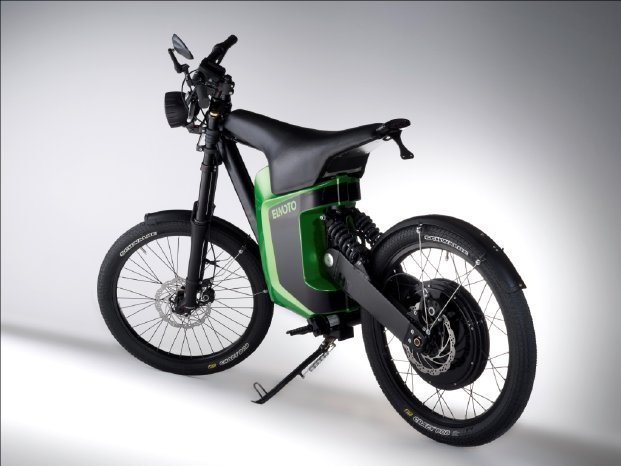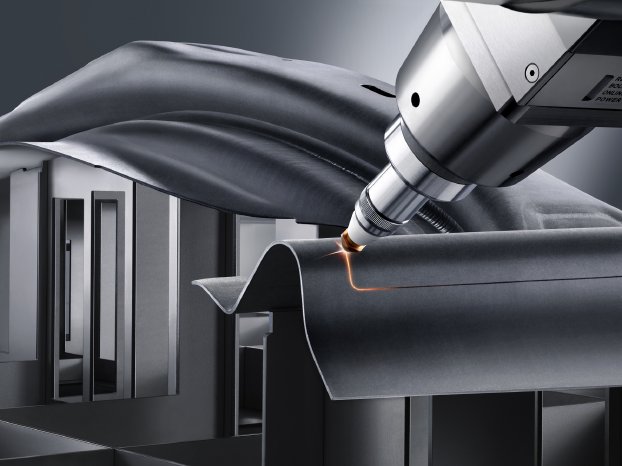Light and stable car body parts
The weight of a car body can be significantly reduced by using press-hardened steels. This steels exhibits very high strength and means less material is required than with conventional designs, which reduces fuel consumption and enhances safety.
Machinery and lasers from TRUMPF are used in many steps in the processing of high-strength steel. TRUMPF will illustrate this process chain at EMO using a Golf GTI.
Most press-hardened car body parts are made of aluminum silicon-coated boron alloy steel, which is normally processed from the coil in a blank cutting press. The flat blanks can also be cut using a 2-D laser cutting machine. This offers the advantage that the parts can be altered flexibly at any time without having to replace expensive cutting tools. Laser processing enables the parts to be nested, which improves material utilization.
The blanks are then heated in a furnace line to render the material plastic and readily formable. TruHeat generators for induction heating can be used for this. HÜTTINGER Elektronik products exhibit higher energy efficiency and can therefore reduce operating costs compared to conventional gas firing technologies.
The heated parts are quenched in a forming press, which endows them with a tensile strength of around 1500 MPa. The high-strength material decisively enhances passenger cell safety, but with conventional processing methods there is hardly any remaining scope for increases in cost-efficiency. That is why manufacturers are turning to 3D laser machines for cutting press-hardened car body parts, and in the TruLaser Cell 8030 with disk laser TRUMPF has developed a special machine which is optimized for this application.
After undergoing further processing the structural parts are welded together to form car body assemblies. 3D welding cells with TruDisk lasers and remote welding optics can be deployed for this purpose. Laser-marked barcodes ensure the finished parts are traceable. Laser marking offers the advantage of durability and high quality.
40 percent time saving on commercial vehicle axle
In addition to the Golf GTI, TRUMPF will be showing a commercial vehicle axle at EMO as an additional example of laser applications in automotive manufacturing. The challenge that must be overcome in axle manufacture is the high carbon content of the material. Conventional welding methods cannot be used because they cause the material to quickly go brittle and start to crack. In the product on display, the axle parts are optimally prepared for the subsequent welding process by pre-heating using TruHeat generators and special inductors. This prevents crack formation and brittleness.
The deep weld seams on the axle edges are laser-welded. This offers the advantage that less heat is introduced into the demanding material, which reduces distortion. Cracks are avoided through the lower thermal loading of the material and through controlled cooling after the welding process, which together increase the loading capacity of the axle component. Weld quality is such that there is no need for mechanical finishing or other additional work. Overall, laser welding allows commercial vehicle axles to be produced in 40 percent less time.
Laser production as the basis for e-mobility
One of the biggest challenges that will have to be overcome in order for electromobility to achieve blanket coverage is the manufacture of fast charging, high-power and long-life batteries for electric motors. These energy stores are not comparable with the lithium-ion batteries used in everyday applications because they have to make a very high power density available in a very short time during vehicle acceleration. These peaks in the current place a very high demand on battery management in terms of both power level and duration. At the same time, recharging must take place very quickly because availability is a criteria of success for the practicability of electric motors.
Future batteries for electric cars will also have to be much more robust in terms of life-cycle duration than has been the case up to now for lithium-ion batteries. The batteries currently used in electric cars have a charging time of around three to four hours and a range of up to 200 kilometers. The aim is to create high-performance single batteries that are more efficient and powerful by combining several battery cells.
Batteries suitable for everyday use are being produced for electric bicycles. As an example, TRUMPF is presenting the ELMOTO at EMO. The battery used on this e-bike comprises a single cell, delivering around 2.2 A. The estimated worldwide market for these bicycles is worth around 50 million euros.
Lasers are an excellent production technology for the manufacture of high-performance batteries, because they can unleash all of their advantages when cutting and welding battery parts such as the housing or cell connectors. Contactless processing keeps the mechanical loading of the material low and the seams free of distortion, as the welding introduces only a small amount of heat locally. Laser technology supports the aim of integrating ever smaller and more powerful cells in a single battery block through its high processing quality and precision in the production and finishing of small components. Since production on laser machines with high productivity and low parts costs is so efficient, it is possible to manufacture large volumes at favorable competitive prices - which is what the automotive market demands.
TRUMPF at EMO, Hanover, September 19 to 24 2011 / Hall 12, booth C72


